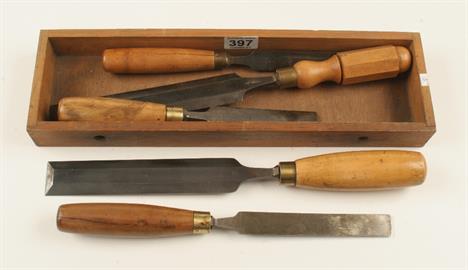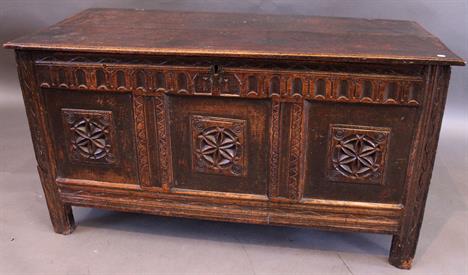THE ART OF ILLUMINATING AS PRACTISED IN EUROPE FROM THE EARLIEST TIMES ..., ill W R Tymms, L, Day & Son Ltd [nd], illuminated chromolitho ttl + 95 plts compl, orig decor cl gt, rebkd, orig bkstrip retained + DECORATIVE ALPHABETS FOR THE CHISEL THE BRUSH THE PEN AND THE NEEDLE WITH CYPHERS MONOGRAMS AND INITIAL LETTERS, L, Houlston & Wright, [1865], 46 plts, orig decor cl, rebkd, new EPs + THE ART OF ILLUMINATING AS PRACTISED IN EUROPE FROM THE EARLIEST TIMES ..., ill W R Tymms, L, Day & Son 1860, illuminated chromolitho ttl pge + 99 plts compl, orig decor cl gt, v worn, bkstrip near detchd, disbnd, contents completely loose, aeg + MONOGRAMS OLD ARCHITECTURAL ORNAMENT SACRED ILLUSTRATIONS BORDERS AND ALPHABETS COLLECTED ON THE CONTINENT AND IN ENGLAND, L, John Weale circa 1852, frontis + 17 plts, old qtr cf worn, lacks bkstrip, complete disbnd contents loose + one other similar (5)
We found 1902 price guide item(s) matching your search
There are 1902 lots that match your search criteria. Subscribe now to get instant access to the full price guide service.
Click here to subscribe- List
- Grid
-
1902 item(s)/page
1st millennium AD. A hand-carved amphibolite situla with flat bottom, slightly waisted sidewall, ridged rim; the bottom dressed with a five-prong stonemason's chisel. The form of the vessel is similar to a number of bronze vessels of 5th and 6th century date, possibly of Byzantine origin, found in princely graves such as that found at in grave 1763 at Krefeld-Gellep, Germany. 2.7 kg, 26.5cm (10 1/2"). Ex Lincolnshire, UK, collection; acquired London 1990s. [No Reserve] Fine condition; repair at rim.
12th-15th century AD. A mixed group of iron arrowheads comprising: one triangular-section, tanged; one leaf-shaped, tanged; one triangular, tanged; one chisel-ended, tanged; two triangular, socketted; one swallowtail, socketted. 110 grams total, 6.5-12.5cm (2 3/4 - 5"). Property of a Surrey collector; acquired in the early 1970s. [7] Very fine condition.
A late 17th Century oak six plank coffer The hinged lid above chisel and guilloche carved front panel, flanked by lozenge carved side panels, raised on shaped end supports, width approx 125cm. CONDITION REPORT: One piece top original blacksmith hinges, front hanging lock clasp missing lock plate missing, left hand upright toward the V shape support, original knot hole piece of timber missing approx 6cms x2cms, opposite V shape support extensively scratched, traces of old worm at the bottom not alive, original board base, discolouration and staining to the top.
A Victorian carved oak kneehole desk, in the 17th Century taste The rectangular top with gadrooned border and inset leather writing surface above three chisel and guilloche carved frieze drawers between acanthus corners and four further blind fret carved drawers beneath, carved and panelled the whole way round so as to sit in the centre of an office, raised on eight sturdy foliate carved baluster and bun legs, width approx. 172cm, depth approx. 80cm.
AN UNUSUAL & FINE QUALITY 19TH CENTURY JAPANESE MEIJI PERIOD IVORY NETSUKE OF A MASK MAKER, unsigned, unusually carved with a moveable rotating head, the head cast downwards, a mask held in one hand and a chisel in the other, the man seated cross-legged on a circular woven mat, 1.25in high & also 1.25in wide at widest point.
A Victorian carved oak settle The chisel carved top rail featuring two carved portrait busts, above the back panel carved with figurative tavern scenes, the hinged seat with carved Anthemion motif enclosing storage space, and further carved panel beneath, raised on paw feet, width approx 106cm. CONDITION REPORT: No obvious damage or woodworm, a few scratches and knocks. In need of a polish
Stone Age Danish Thick-Butted Polished Chisel Neolithic, 5000-3000 BC. A finely made thick-butted chisel with parallel sides and narrow, polished cutting edge; in a grey flint. 532 grams, 15cm (5 3/4"). Property of a gentleman, by descent from the vendor's father, who formed his collection in the 1990s; found Denmark in the 1920s. Very fine condition.
Bronze Age Decorated Socketted Chisel 1200-800 BC. A narrow cast chisel or gouge with c-shaped square cutting edge, flared tubular socket, ribbed mouth, Y-shaped rib to the upper face; casting seams to the sides. 72 grams, 90mm (3 1/2"). From an old Munich collection; acquired on the German art market before 2000. [No Reserve] Fine condition.
Bronze Age British Socketted Chisel 950-750 BC. A cast chisel comprising tubular socket with collar to the mouth, circumferential band of raised pellets, rectangular section blade with flared, slightly concave, edge. 156 grams, 14.5cm (5 3/4"). Ex Sir Richard Ground (1949-2014) Collection, Derbyshire, UK; acquired privately, 2008; reportedly found Somerset, UK, 1978. Cf. Evans, J. The Ancient Bronze Implements, Weapons and Ornaments of Great Britain and Ireland, London, 1881, item 200. Sir Richard Ground notes that 'the biconical collar argues for a late date contemporary with Sompting axes in the Lyn Fawr period.' Each piece from the collection is accompanied by Sir Richard's personal illustrated catalogue sheets which describe the piece fully, give details and circumstances of his acquisition, academic references and general notes. The eminent lawyer Sir Richard Ground, OBE (1949 - 2014), a graduate of Lincoln College Oxford, was called to the bar at Gray's Inn in 1975. After a period spent specialising in media law, he was, in 1983, appointed Crown Counsel in the Cayman Islands, a position which he held until 1987 when he assumed the role of Attorney General. He served as Chief Justice of the Turks and Caicos Islands from 1998 to 2004, and then as Chief Justice of Bermuda until his retirement in 2012. Highly regarded in legal circles for his decisiveness and impeccable integrity, he was awarded the OBE in 1991 in recognition of his services to the Cayman Islands, and was made a Knight Bachelor in 2012 for services to justice in Bermuda. He had a passion for the natural world and worked alongside his wife, fellow lawyer Lady Ground, to found the National Trust for the Cayman Islands, as well as publishing several volumes of wildlife photography. Sir Richard was a keen and knowledgable collector of both coins and ancient weaponry. His collection of Roman, Byzantine, English, and European coins fetched exceptional prices when sold by Spink in September 2014. It is with pride that we are able to offer his collection of Bronze Age weaponry for auction. [No Reserve] Very fine condition.
Medieval Iron Arrowhead Collection 12th-16th century AD. A mixed group of large arrowheads comprising: one tanged, three blades; two tanged, leaf-shaped; one tanged, chisel type; one tanged, rhomboid. 122 grams, 11-14cm (4 1/4 - 5 1/2"). Property of a Surrey collector; acquired in the early 1970s. [5, No Reserve] Fine condition.
* Norfolk/Cambridgeshire - Drainage of the Fens. A manuscript indenture of 13 parts concerning the Sessions of Sewers, 16 July 1631, between the Right Honourable Francis Earl of Bedford and his adventurers, Oliver Earl of Bullingbrooke, Edward Lord Gorges, Sir Robert Heath, Knight, His Majesty`s Attorney General, Sir Miles Sandys of Wilberton, in the Isle of Ely, in the County of Cambridge, Sir John Charleton, Sir William Russell, Sir Robert Bevel, Sir Thomas Tyringham, Sir Robert Bell, William Sames and Samuel Spalding, calligraphic initial, 4 chisel-slits (from disinfection?), a little minor soiling but ink strong and legible, 64 x 74 cm with twelve red wax seals appended, all largely complete with a few impressions still faintly visible, endorsed. Francis, Earl of Bedford, undertook the public work of draining the Fens, the Earl and his adventurers being due to receive from the proprietors 95,000 acres being nearly a third part of the whole. The Earl of Bedford employed Cornelius Vermuyden as engineer, who become involved for the second phase of construction in the 1650s. The scheme was imposed despite huge opposition from locals who were losing their livelihoods based on fishing and wildfowling. Fenmen known as the Fen Tigers tried to sabotage the drainage efforts. (1)
Masonic Regalia : A large quantity of assorted aprons, sashes, ephemera etc relating to 'Mallet & Chisel Master Masons Lodge , Goliath Chapter No. 5595 and Atlas Lodge No. 6083. Includes cases , jewels, gloves, sashes etc CONDITION: Please Note - we do not make reference to the condition of lots within catalogue descriptions. We are however happy to provide additional information regarding the condition of items on request.
Stone Age Danish Thick-Butted Polished ChiselNeolithic, 5000-3000 BC. A finely made thick-butted chisel with parallel sides and narrow, polished cutting edge; in a grey flint. Cf. Glob, P. V., Danske Oldsager, number 247. 636 grams, 18cm (7"). Property of a gentleman, by descent from the vendor`s father, who formed his collection in the 1990s; found Denmark in the 1920s. Very fine condition.
Bronze Age Punch and Ferrule Group2nd millennium BC. A group of bronze items comprising: a tapering rectangular-section chisel with lateral wings, the shank foreshortened; a hollow-cast ferrule with flared biconical lower end, pelletted bands to the equator and mouth. Cf. Evans, J. The Ancient Bronze Implements, Weapons and Ornaments of Great Britain and Ireland, London, 1881 items 196, 425. 124 grams total, 65-74mm (2 1/2 - 3"). Ex Northern English collection; found Cumberland, UK, 1990s [2, No Reserve]Fine condition.
Greek Aegean Bronze Chisel2nd-1st millennium BC. A substantial cast chisel or flat-axe with slightly flared blade, rectangular-section body and splayed butt; mounted on a custom-made stand. Cf. Branigan, K. Aegean Metalwork of the Early and Middle Bronze Age, Oxford, 1974, item 600. 659 grams, 16cm (6 1/4"). Property of a West London gentleman; acquired between 1980-2010. [No Reserve]Extremely fine condition.
An African spear, the well formed lanceolate blade with pronounced medial ridges, the haft with shrunk on hide band and small chisel shaped blade at the base, 56? overall; and another African spear, with similar blade, plain haft, and small leaf shaped blade at the base, 76? overall. Basically GC (require cleaning) (2)
An African spear, with plain lanceolate blade, short wire bound wooden haft, and long lower iron spike, 57? overall; another, with similar blade, wooden haft and chisel shaped lower spike, 63? overall; and a Masai type spear, with long slender blade of z section, short wooden haft, and long slender lower spike, 76? overall. Basically GC (require cleaning) (3)
2 short African spears, with leaf shaped blades, partly wire bound hafts, and small WM ferrules, 51? and 57? (wire binding loose on the shorter); another, with partly iron wire bound haft and chisel shaped lower point, 59? overall; and another, with shrunk-on hide section and lower iron spike, 47? overall. Basically GC (require cleaning). (4)
A 17th/18th century oak coffer, the three panelled hinged lid above a chisel carved frieze and two plain panels, raised stile feet, approx 112cm wide CONDITION REPORT: Top - splits, scratches, stain marks old hinge, pins rusted Sides - scratches, scuff marks, side panels move when coffer moved Inside - hinges replaced, repair to central top panel, bottom replaced Front - scratches, scuffs, right panel split Movement of carcass when pushed see images
A good quality period style solid oak tall corner cupboard believed Titchmarch & Goodwin,the moulded cornice above a carved double domed arch and two shaped open fronted shelves, the base section fitted with a chisel carved and panelled cupboard door, raised on bracket feet, width approx 74cm CONDITION REPORT: Height 180cm Depth 50cm Width 72cm
-
1902 item(s)/page
![THE ART OF ILLUMINATING AS PRACTISED IN EUROPE FROM THE EARLIEST TIMES ..., ill W R Tymms, L, Day & Son Ltd [nd], illuminated](https://cdn.globalauctionplatform.com/016740b8-3ffa-4f2f-9883-a46e00b99862/190c4ae8-9bd9-4859-dda9-690d5235a556/468x382.jpg)
























































